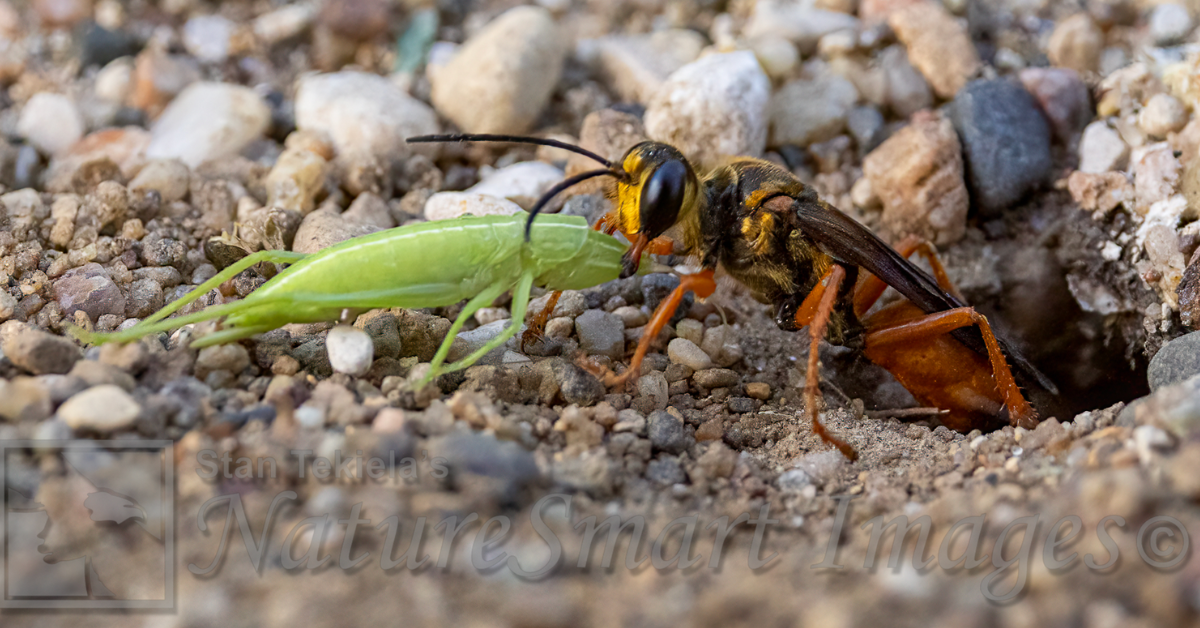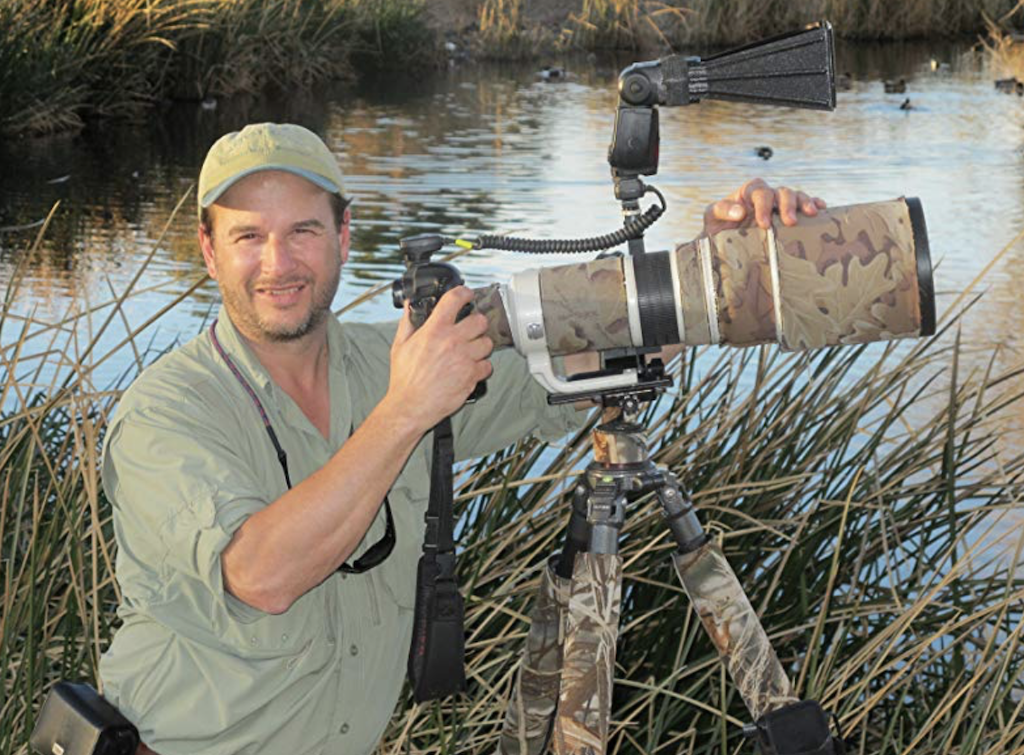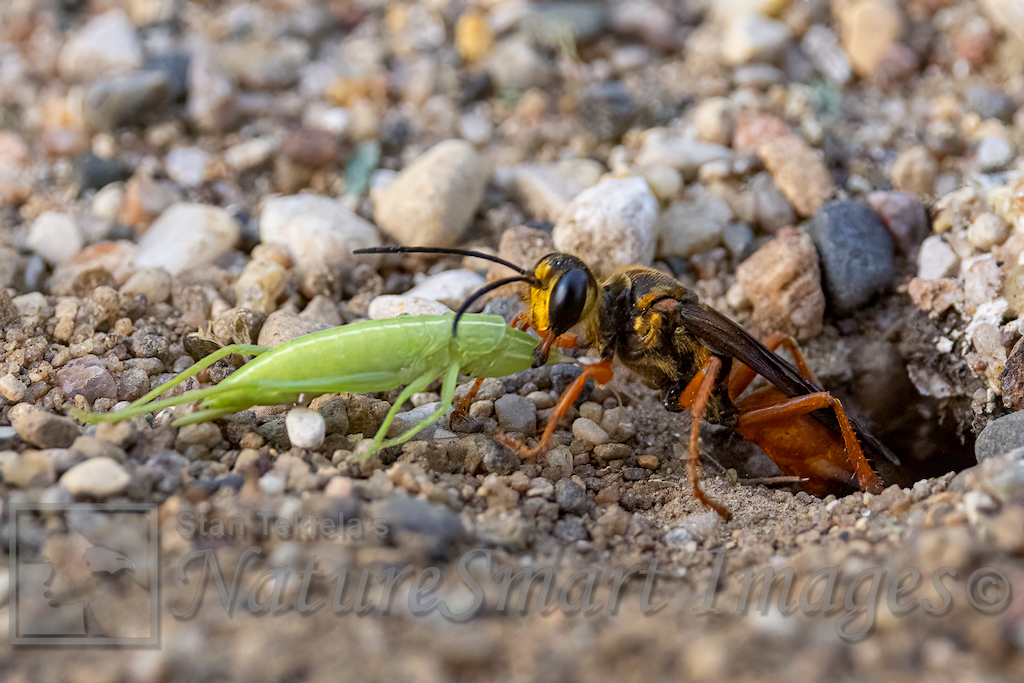
The Great Golden Digger Wasp—Part of the Intricacy of Nature
Wildlife photographer and naturalist Stan Tekiela shares his knowledge about the intimidating Great Golden Digger Wasp. Follow along!

There are plenty of super-cool things to see in nature. For instance, I was working in my yard when I heard what sounded like a huge insect flying past me. The buzzing sound was remarkably loud; when I looked over, I immediately saw a giant wasp carrying another insect that was at least its own size. Carrying a heavy load would explain why the buzzing sound was so loud. The effort it takes for an insect to carry twice its own weight puts a lot of demand on the wings, producing a more audible sound, much like a truck engine that is moving a heavy load sounds much louder as it zooms down the road.
From its bright orange, red, and black markings, I could see this was a Great Golden Digger Wasp (Sphex ichneumoneus).
These wasps are large and intimidating. They are over an inch long and have bright red-and-orange markings on their bodies and legs. They have large dark wings, which they are constantly flicking and twitching. In addition to looking nasty, they also do some ugly things. They have beautiful golden “hairs,” called setae, on their head, hence the name “Golden.” Like many other wasps, the Great Golden Digger Wasp belongs to the “thin-waisted” wasp family (Sphecidae). They have a noticeable narrow area between their thorax and abdomen, approximately where a waist would be.

These amazing wasps are solitary ground nesters. They look for loose sand or gravel, where they will dig a short tunnel several inches into the ground. From this main shaft, they dig smaller side chambers where they will lay eggs, and this is where things get nasty. Before the female lays an egg in one of the underground chambers, she goes out and finds a grasshopper or katydid and attacks it. The wasp stings the prey and delivers just enough venom to paralyze but not kill the insect. She then grabs the paralyzed victim and flies back to the egg chambers.
When the wasp lands at the nest, she leaves the paralyzed victim at the entrance hole, positioned so the head is facing the entry. She goes inside to lay an egg in one of the side chambers. Then she quickly crawls out, grabs the victim, and drags it inside. She will seal the victim in the chamber with the egg.
Yep, you guessed it: When the wasp egg hatches, it will feed on the paralyzed—yet still living—insect. The adult wasp harvests live victims and seals them inside the egg chamber so the young larva has a fresh meal when it hatches.
In my mind, this sounds like science fiction at its finest, but this is real life! Insects preying upon other insects is not unusual, but this takes it to another level. Just the thought of still being alive but paralyzed and unable to do anything—and then being stuffed into an underground chamber and eaten alive—is almost too much.
I spent a couple of hours watching about five or six Great Golden Digger Wasps flying out and returning with prey after prey. They would fly around and around the nest before landing and starting the process again by dragging a victim into the chamber and then heading back out.
The intricacy of nature has kept me interested and fascinated for my entire life. It keeps the fire of wonder and the desire to seek understanding burning deep inside me. I can find utter contentment in watching and learning about all the aspects of nature, even if what I see is sometimes gruesome and frightening.
If you enjoyed Stan’s post, you might like one of his excellent nature books: Wild Birds, Backyard Birds: Welcomed Guests at our Gardens and Feeders, and Bald Eagles: The Ultimate Raptors.
You can follow Stan on Facebook and Twitter or contact him via his web page. Stan’s nationally syndicated NatureSmart column appears in more than 25 cities spanning 5 states (Minnesota, Wisconsin, Michigan, Illinois, and Pennsylvania) and is circulated to more than 750,000 readers.
For more stories about wildlife and nature, sign up for our newsletter now!


